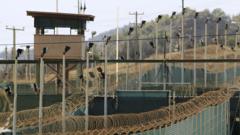**The transfer reflects ongoing efforts to reduce the detainee population ahead of key legal proceedings related to the 9/11 attacks.**
**Historic Transfer: US Relocates 11 Yemeni Detainees from Guantanamo to Oman**

**Historic Transfer: US Relocates 11 Yemeni Detainees from Guantanamo to Oman**
**In a significant move, the US transfers 11 detainees from Guantanamo Bay, marking the lowest number held in the facility's history.**
The US Department of Defense has announced the transfer of 11 Yemeni detainees from Guantanamo Bay to Oman, leaving only 15 detainees at the facility—the lowest number recorded since its establishment. This transfer occurred early Monday and is notable as it is the largest single relocation under President Joe Biden.
The Department of Defense credited Oman for its collaboration in supporting US initiatives aimed at responsibly decreasing the detainee count and ultimately closing the controversial prison. None of the detainees, who were captured in the aftermath of the September 11 attacks, had been charged with any crimes throughout their prolonged detainment exceeding 20 years.
This latest transfer comes just before the anticipated guilty plea of Khalid Sheikh Mohammed, the alleged mastermind behind the 9/11 attacks, who is set to plea in exchange for avoiding the death penalty. With this transfer, three of the remaining detainees have also been deemed eligible for relocation.
The individuals transferred include Moath al-Alwi, who had been approved for release in 2022 and became known for his passion for building model boats from prison scraps. Another detainee, Shaqawi al Hajj, had gained attention for staging multiple hunger strikes in protest of his indefinite detention.
The US government has refrained from sending detainees back to Yemen due to the ongoing civil conflict, labeling the country too precarious for safe repatriation. Efforts to resettle this group began several years ago. The Defense Department noted that the transfers were made consistent with national security interests as assessed by federal review panels.
The prison at Guantanamo Bay, located within a US military base in Cuba, was established by the Bush administration in 2002 to detain individuals captured in anti-terror operations. At its peak, it housed around 800 detainees, but it has faced longstanding criticism pertaining to the treatment of those held, as well as the legality of their extended detainment without formal charges.
Former President Barack Obama’s administration promised to close the facility, citing its erosion of US values and potential to damage international relationships critical for combating terrorism. Nevertheless, congressional opposition and resilience from the subsequent Trump administration, who sought to keep the prison open, stymied those efforts.
Since taking office, President Biden has committed to reducing the Guantanamo detainee population, although the complete closure of the facility remains uncertain in light of America's evolving political landscape.
The Department of Defense credited Oman for its collaboration in supporting US initiatives aimed at responsibly decreasing the detainee count and ultimately closing the controversial prison. None of the detainees, who were captured in the aftermath of the September 11 attacks, had been charged with any crimes throughout their prolonged detainment exceeding 20 years.
This latest transfer comes just before the anticipated guilty plea of Khalid Sheikh Mohammed, the alleged mastermind behind the 9/11 attacks, who is set to plea in exchange for avoiding the death penalty. With this transfer, three of the remaining detainees have also been deemed eligible for relocation.
The individuals transferred include Moath al-Alwi, who had been approved for release in 2022 and became known for his passion for building model boats from prison scraps. Another detainee, Shaqawi al Hajj, had gained attention for staging multiple hunger strikes in protest of his indefinite detention.
The US government has refrained from sending detainees back to Yemen due to the ongoing civil conflict, labeling the country too precarious for safe repatriation. Efforts to resettle this group began several years ago. The Defense Department noted that the transfers were made consistent with national security interests as assessed by federal review panels.
The prison at Guantanamo Bay, located within a US military base in Cuba, was established by the Bush administration in 2002 to detain individuals captured in anti-terror operations. At its peak, it housed around 800 detainees, but it has faced longstanding criticism pertaining to the treatment of those held, as well as the legality of their extended detainment without formal charges.
Former President Barack Obama’s administration promised to close the facility, citing its erosion of US values and potential to damage international relationships critical for combating terrorism. Nevertheless, congressional opposition and resilience from the subsequent Trump administration, who sought to keep the prison open, stymied those efforts.
Since taking office, President Biden has committed to reducing the Guantanamo detainee population, although the complete closure of the facility remains uncertain in light of America's evolving political landscape.





















